Major William James Boggie, Jane ‘Jeannie’ Marr Boggie nee Manson and Alexander Boggie.
By Bob Manser and assisted by Eddy Norris.
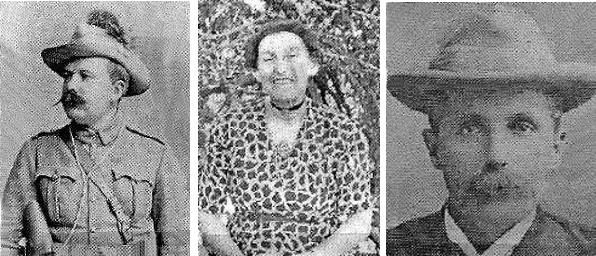
This article is a very amateur potpourri of historical facts and anecdotes about some resolute and courageous but somewhat forgotten Rhodesian pioneers - The Boggies.
We have put all this information together in case much of the history of the lives of Major and Jeannie Boggie and Alexander Boggie gets lost forever.
Regrettably this so often happens to historical accounts and events if they are not put down in writing. Memories fade, relatives and friends pass on and so does the history.
Both Eddy Norris and myself are not skilled or experienced writers but both of us have an avid interest in the pioneer history of Rhodesia .( now Zimbabwe) We have compiled this article as best we can, but hopefully someone in the future with more journalistic skills can produce a more professional edition.
Our aim was plain and simple- to get as much information as possible on the Boggie family history and get it posted to a website for all future generations to see.
We have taken extracts and articles from various sources and there will be no monetary gain from this exercise.
We have not done the research for this article alone and owe a great deal of thanks to numerous folk that have done extensive research on our behalf; supplying documents, photographs, anecdotes and facts, and in some cases just lots of encouragement. We thank them all no matter how big or small their contribution.
Special thanks go to Alex “Akki” Manson , nephew of Jeannie Boggie and to his daughter Anne Manson; Dr. Ken Rice of Edinburgh University; Duncan Wallace; Willy Jervois, resident genealogist, Albany Museum, Grahamstown; Angela Hurrell; Evelyn Munroe; Colin Lyle; Cedric Herbert , Emma Assane, and many other folk who have sent in acknowledged anecdotes .
To Eddy Norris, special thanks as without his skilled computer input, this history of the Boggies would not have come about and been available on a website.
We have used pre Zimbabwe Independence names for places and towns, as all this history occurred in the then Rhodesia. Before Independence in 1980. Since then names have changed, examples: Rhodesia now Zimbabwe, Gwelo now Gweru, Wankie now Hwange, Salisbury now Harare.
Considering how much Major and Jeannie Boggie did for Gwelo in particular and Rhodesia as a whole, it was rather disappointing to discover during our research work what little information was available about them, and how uninformed the citizens of Gweru and Zimbabwe are these days of the part that the Boggies played in the early days of the country.
We have included Alexander Boggie in this article as he was the Major’s brother and also a pioneer in the new Rhodesia.. He has little or anything to do with the main subject of Jeannie and Major Boggie and the town of Gwelo. However he deserves a mention as little is known or written about him. It is also unusual in that there is hardly any evidence of much, if any, social contact between the two brothers throughout their lives in Rhodesia.
--------------------------------------------------------------------------------------------------Gwelo
I feel a brief mention here is necessary about the initial history of Gwelo as a very large part of the life of Jeannie Boggie was spent in this small town ( 50 years 1917-1967) plus also the Major was very involved in the day to day affairs of this town in his latter years ( late 1890’s -1928)
After the pioneer column reached Salisbury in 1890, the country started to expand rapidly as it was believed to be a second gold rich area like the Rand of South Africa. Things slowed down to some extent due to the Matabele and Mashona rebellions of 1893 and 1896, and just as the new arrivals thought peace had come, the second Boer War erupted in 1899-1902. So the country only really settled down after these events.
It is believed that one of the pioneer column scouts, Burnham first pegged the town with Leander Starr Jameson in early 1894 and the town was originally going to be called Jamesontown. However it eventually was to be known as Gwelo, as the nearby was the Gweru River and the name was anglicized to Gwelo.
In those early days travel was a hard and lengthy process as there were no roads, only tracks and all transport was by horse, ox wagon, later horse drawn Zeedeburgh coaches and for some folk even on bicycles or on foot.
The two main towns in early Rhodesia were Bulawayo in the south, and approximately 260 miles northwards was the country capital Salisbury. Naturally there had to be numerous refreshment points between these distant towns and so various smaller towns blossomed such as Gwelo which was approximately 100 miles north of Bulawayo.
One of the first hostelries in Gwelo was the Horseshoe Hotel built by Major William Hurrell. Out of interest, he later sold this pole and dagga establishment to the Meikle Brothers. They in turn demolished it and had built in it’s place the Midlands Hotel which is still there to this day ( 2011)
Sometime after the second Boer War and the beginning of the First World War, Major Boggie purchased a tract of land on the outskirts of the town and named it Craigievar Farm.
Mrs. Jeannie Marr Boggie MBE 1876-1967
Jane Marr Manson was born on the 25th July 1876 at Kilblean House, Parish of Meldrum, Aberdeenshire.
Her father was James Bruce Manson and her mother was Jane Alison Manson (nee Marr). One census states that her father was a farmer of 220 acres and employed 8 labourers so it would appear that the Mansons were people of some consequence.
I have been in contact with Alex “Akki” Manson, Jeannie’s nephew (80 years old in 2011) and he says she was the youngest of three sisters and a younger brother . The sisters were Alison and Agnes and her brother was Alexander who was Akki’s father. It appears in the census dated 1901 that the only two siblings resident in the house at that time were Jeannie then aged 24 and her brother Alexander aged 14. The two elder sisters presumably had married and moved out. There were a few other names mentioned in the census who were presumably house and farm staff.
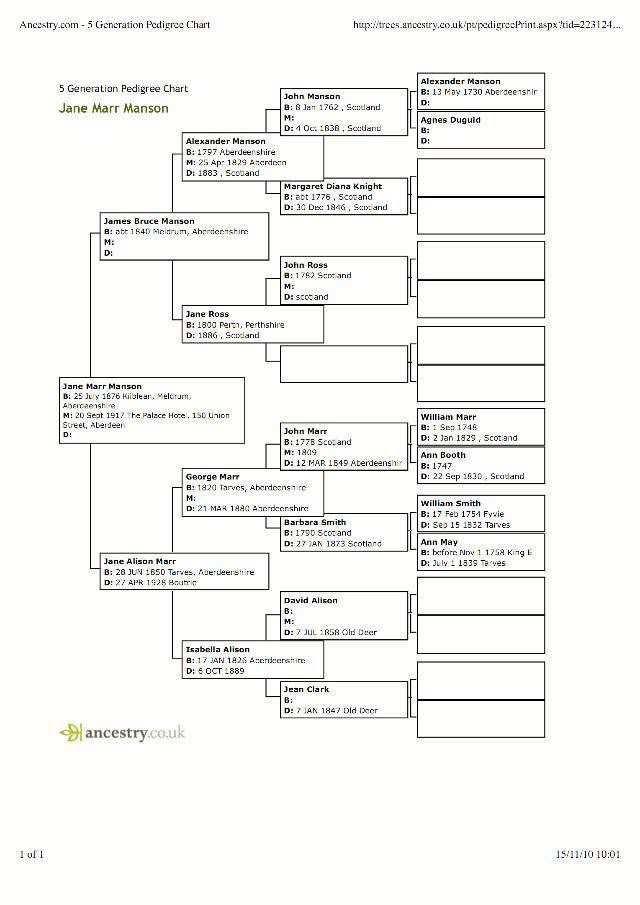
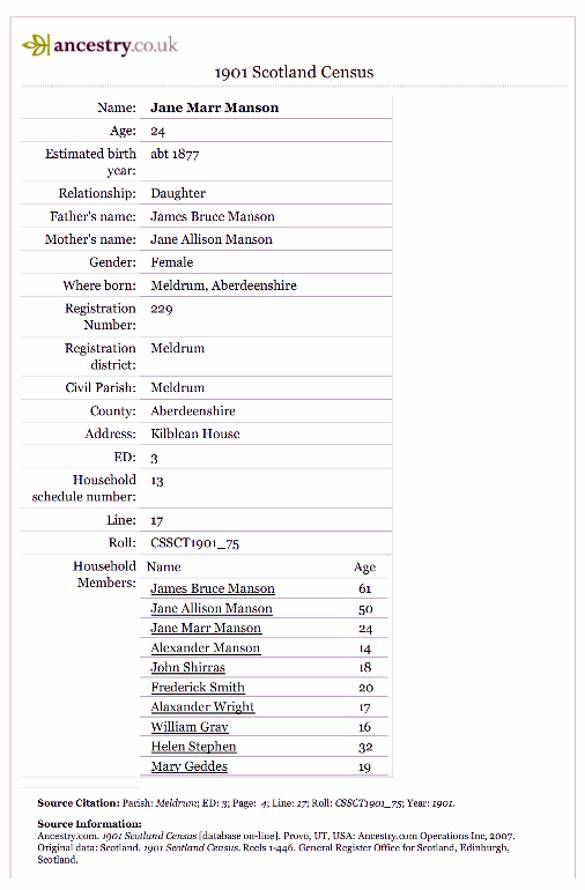
It appears Jeannie was closer to her young brother Alexander and had more affection for him than any other member of the family.
Jeannie’s nephew Akki goes on to mention that his father Alexander was reported killed in the Somme in WW1 but actually survived minus an arm.
Not much is known of Jeannie’s early days in Scotland, with no mention of schooling, possibly taught by a governess or at a local school. She was however, an accomplished horse women, and of a very practical nature. Coming from a farming family, she had a good knowledge of farm life which was to eventually be invaluable to her in her later years in Rhodesia.
She was also brazen and audacious enough to be an outspoken suffragette . That certainly took courage in those Victorian days as suffragettes often had to put up with insulting remarks from, or being snubbed by men folk of that time who were hostile to the thought of equal voting rights for women.
Her third cousin was Major William James Boggie and due to this family relationship there must have been a fairly regular amount of social interaction between the Mansons and the Boggies over the years.
She was secretly engaged to the Major about 1900 or so, and it was rather a long engagement with only her brother Alexander and his fiance Isabel in the know.
Left to right- Jeannie, Major Boggie, Jeannie's brother Alexander and his fiance Isabel
Major Boggie was a military man through and through and spent much of his time away from Scotland on various military campaigns ( more detail later) and Jeannie had to wait 17 years before her husband to be returned to Kilblean , and they eloped and married.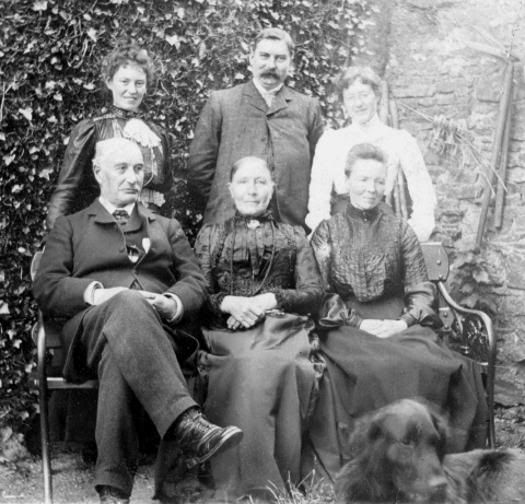
Kilblean House 1904,
Left to Right-
Front Jeannie' father, J.B. Manson and his wife Jane, and
Mrs Boggie ( The Majors Mother) next to her
At back, Jeannie on the left with possibly the Majors father
and unknown lady.
James Bruce Manson with daughter Jeannie Kilblean House 1912
THE ELOPEMENT
Jeannies own account of events: One day at breakfast time in September, 1917, a noisy motor car drew up at Kilblean, Aberdeenshire, my Scottish home. With military bearing, out stepped Major Boggie , my third cousin, whose home was in Rhodesia, but who had been serving with the French army in the First World War.
In stepped I, brown eyed, rosy checked, freckle nosed Jeannie M Manson, wearing my Sunday best clothes. Down stairs stepped my father,” where are you going?” to Rhodesia with Major Boggie, then I whispered to the Major “ Go on inside and tell them all about it, I will wait in the car.
And that was the first intimation which my parents received of my elopement with Major Boggie to whom I had been secretly engaged since his last visit to his old mother nearby, when invalided from the Boer War, seventeen years ago.
Fond farewells ! and the Major and I were off to Aberdeen to be married by special licence. It was an easy way of being married- just a document known as a Decree of Declaration to be drawn up by a lawyer and signed by us two in the presence of two witnesses. This declaration is further signed by the Registrar of Marriages and again by the Sheriff.
So there we were-Major and Mrs Boggie, for better or worse, for richer or poorer, until death did us part in 1928.
An extract from Jeannie’s fathers diary of the events of the day :
Wednesday 19th September, Major Boggie called but did not come in . Jeannie and he seemed to have a conflab. 20th September, there was a sale at Old Meldrum but I did not attend. Saw Jeannie at 10am and asked her if she was going anywhere and she replied “I am going away and not coming back again” I was awfully surprised and a few minutes later , Major Boggie arrived in a closed motor car and explained matters and off the two set for Aberdeen and got married by special licence by the Sheriff at 1pm. The two then started for London in the evening on their way to South Africa. Neither of them had ever intimated previously any proposal of marriage to my wife or self. We saw that they were very fond of each other and drove out a lot with each other for sometime back. I felt terribly upset all day . Her Mother and I will miss her very much indeed and it all came upon us so suddenly. I felt dazed and could not realize it had all happened.
I have a copy of the marriage certificate , but it is of too poor quality to reprint here. It states as follows:
20th September, 1917, at the Palace Hotel, 150 Union Street, Aberdeen.
Major William James Boggie, rancher, bachelor and Jeannie Marr Manson, spinster.
The Major of Craigievar Farm, Gwelo , Rhodesia, Jeannie of Kilblean House , Old Meldrum, Aberdeenshire.
Major: Father, Alexander Boggie , deceased (land proprietor) Mother, Elizabeth Boggie.
Jeannie: Father and mother, James Bruce and Jane Alison Manson.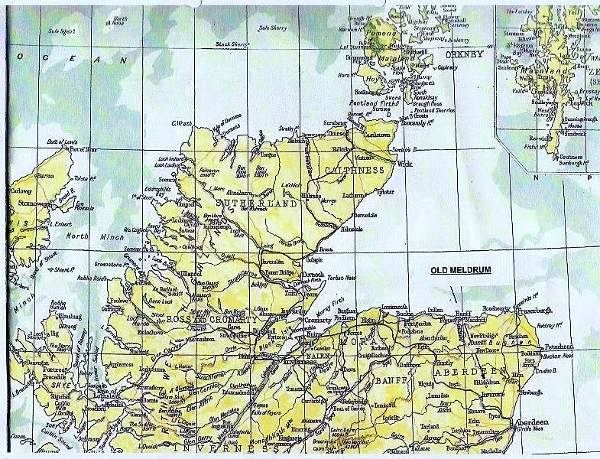
Map illustrating Old Meldrum
TRIP TO RHODESIA
Despite warnings that Waterloo Station had been bomb damaged, they managed to catch a train to the nearest port and set sail in the troopship, Balmoral Castle, for South Africa. Among the passengers oddly were a few other folk destined for Gwelo.
Little is known of the voyage to Cape Town except that there was a submarine scare somewhere in the Atlantic as WW1 was still very much on the go. Rather brave of them to attempt this voyage as there was a lot of German submarine activity around the South African coast at that time.
On Arrival in Cape Town, they immediately set off by train for Rhodesia and arrived in Gwelo some weeks later. It must have been a shock and a real change of scenery and lifestyle that Jeannie was used to, having gone from the fairly civilized Scotland she knew so well to the rather harsh, hot and arid farm Craigievar on the outskirts of the tiny town of Gwelo. The thought of living in Gwelo and running a farm must have been rather daunting to this new bride.
It must be remembered though that these were no young honeymooners, Jeannie was 40 and the Major 55.
The many incidents and anecdotes of Jeannie’s day to day farm life are well chronicled in her own book, “A farm and a Husband in Rhodesia” so I will not go into detail of her farm life which she actually kept up for 50 years.
Whilst on the subject of books, Jeannie in her latter years wrote two other books “Experiences of Rhodesian Pioneer Women” and “First Steps In Civilizing Rhodesia”
For these last two books she received a personal letter of appreciation from the President of the British South Africa Company’s Pioneer Column Society.
Dated: 17th November, 1948
Dear Mrs. Boggie. In presenting to you, by the courtesy of the Mayor of Gwelo the Eblem of the Pionner Column of 1890, the Pioneer Axe, we wish to record the esteem and regard which you are held by us,as by your books, "Experiences of Pioneer Women" and "First Steps in Civilising Rhodesia", you have brought honour to Rhodesia's heroines and made their deed an inspiration to succeeding generations. By your patience in eliciting and your skill in collating and presenting the scattered facts which build up those unique pictures of Rhodesia's past, you have brought honour to yourself and given an example for later historians to follow. We wish you many more years of good health and conteniment in this country of ours.
Yours sincerely,
PRESIDENT"
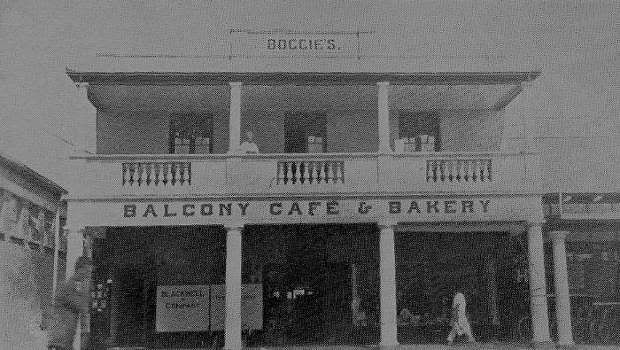
Her beloved Major passed away after only 11 years of marriage in 1928 but Jeannie carried on stoically running the farm and other businesses as she knew her Major would have wished.
Eccentricity
After the Major passed on, there were various rumours of Jeannie’s rather eccentric behaviour regarding the Major and his burial site.
She did initially have him buried on a small knoll on the farm. After some years though, she for some bizarre reason, exhumed him. This was supposedly because she wanted him above ground in a vault.
This bought about the rumours that on her mantelpiece was a the skull of the Major covered in a cloth, however this was only the skull of her beloved horse Ruben.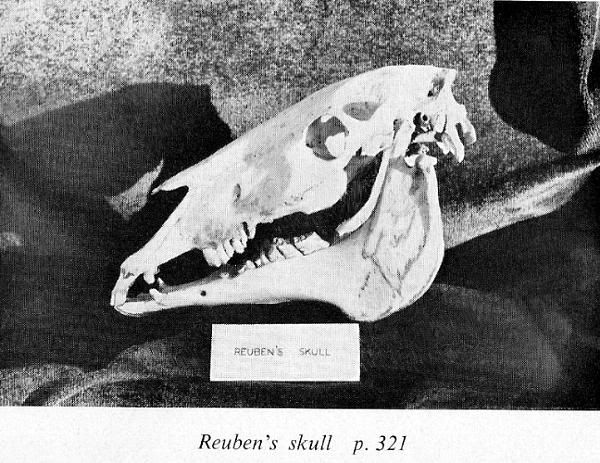
She does openly admit that she dug up the Major with the help of her servant and they laid out the bones in a box under her bed in the shape of a skeleton. She proudly says that the only piece missing was one knee cap.
In another remark by her about all this, she maintains that the Major was buried in a plain wooden coffin, and she exhumed him in order to place him in a more distinguished lead lined coffin.
After some years as a lonely widow she decided to take a years break away from Gwelo, possibly brought on by grief and pure physical and mental exhaustion. She was advised by the Major before he died that if she ever needed a man to help her with the business affairs whilst she was away, she must choose his very god and trustworthy friend Mr. X .
On leaving Craigievar , she handed over the running of the farm and businesses to the capable and trustworthy gentleman and returned to her home in Kilblean for a well earned rest.
After 6 months or more being away she started to receive ominous letters saying all was not well at the farm and she was urged to return as soon as possible.
This she did and what a shock she had on arriving back home. The farm was a total shambles, and in a terrible state. On top of this her various businesses in the town had been defrauded of funds by the trustworthy Mr. X.
With her usual strength of character, she slowly sorted out the farm and her other business interests and eventually got everything back to normal. She does state that the fraudster eventually committed suicide owing to the heavy burden of guilt he suffered at the disgrace of his misdemeanors.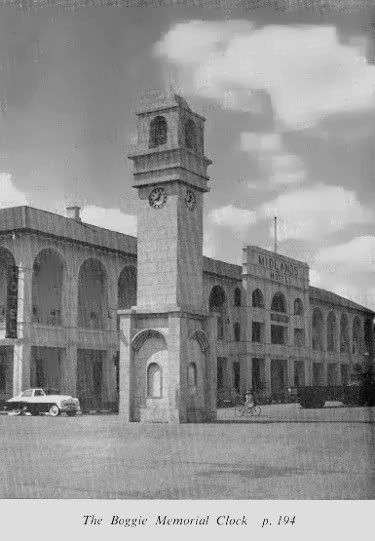
The Boggie Clock
No article on Jeannie Boggie would be complete without a word or more on the saga of Gwelo’s main historical monument, THE CLOCK. Loved by some, hated by others.
About 1937, Jeannie had one of her slightly eccentric ideas to put up some form of monument, dedicated mainly to her beloved Major but also to the memories of pioneers of early Rhodesia.
This clock was positioned in a fairly reasonable position in 1937 but owing to growth of Gwelo and the massive increase of cars on the road, it now appears to be somewhat awkwardly placed.
I quote from part of a humorous anecdote by John Musell.: Jeannie set about attempting ways to perpetuate the Majors memory. She funded the Boggie Clock which was placed on a substantial plinth at the intersection of town of Gwelo’s main roads. Over the years this stocky monument served as a road safety feature although some would say , a hazard. During weekends in more recent times it has no doubt displayed magnetic properties towards meandering cars, leaving panel beaters rubbing their hands with glee on Monday mornings.
The clock tower was originally fitted with Westminster type chiming bells, and they would loudly ring at the time all hours of the day and night. Regrettably the clock was placed only a few hundred metres from the large Midlands Hotel and this annoyed hotel patrons so much especially when a peel of 11 or 12 bells rang out at night, that the Gwelo council had the bells removed just leaving the timepiece.
Jeannie with her usual tongue in cheek humour penned the following poem relating to this episode.
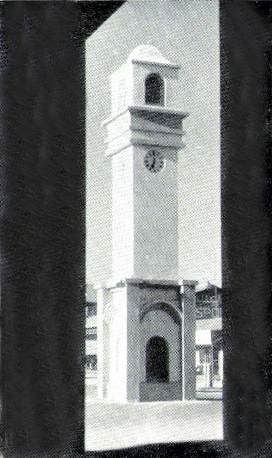
The Boggie Memorial Clock, Gwelo
Photo: E.T. Brown Umtali
HICKORY, DICKORY, DOCK
THE
BOGGIE MEMORIAL CLOCK
HICKORY, dickory, dock,
A beautiful chiming clock.
Was gifted to Gwelo and sits on high:
All eager and willing its chimes to cry.
But alas, the people who live nearby,
Said : " Chimes through the night will our temper try;
And lack of attention makes each one sigh."
For how to manipulate clocks that chime,
Has given to Gwelo puzzling time.
Those chimes, all silent, are longing to fly
'Way back to London and ring out on high;
Where chimes arc as common as eight-day clocks,
" So please ship us back to the London docks."
n the following article by Maxwell Katakamba of the local Gweru newspaper written in 2011, it is heart warming to read that the more modern citizens of Gweru have not forgotten Mrs. Boggie and that her clock is still in good hands and well maintained by the Gweru Council.
THE CLOCK THAT MARKS GWERU COMMUNITY
Extracted from the Newsday , Maxwell Katakamba , own correspondent, Gweru 13/5/2011
As the battle to demolish Gweru’s landmark Boggie’s clock tower reached fever pitch, the Zimbabwe Broadcasting Corporation on September 18th, 1980, reported that if the structure was destroyed, visitors would get lost, not knowing whether they were in Gweru.
Situated at the intersection of Main Street and Robert Mugabe Way, the clock tower was erected in 1937 by Jeannie, the widow of Major William James Boggie in memory of her late husband.
The Major , who was once the MP for the Midlands area in the Rhodesian parliament, is best remembered for having put forward the original Bill of Legislation for the establishment of Hwange Game Reserve.
The foreign currency earner is now a sanctuary to one of Africa’s largest wildlife herd.
Described by the late estate agent, Trevor Dollar in records kept at the former Kamuza Banda cell turned repository at the Old Prison Complex National Archives in the Midlands capital. “ Jeannie was one of our funny people, she was an outspoken person who once took on a full army, the Rhodesian Air Force to be exact, and lambasted them for low flying of aircraft at Thornhill Air Base.
She complained that her cattle at nearby Craigievar Farm were no longer producing milk because of the noise the planes emitted.
During construction of the structure, Jeannie who did not want to visit other washrooms in town, had an underground toilet built a stone’s throw away from the tower.
Today, an enterprising gentleman is renting the facility from the local authority as a pay toilet.
As the time ticked on, residents at the nearby Midlands Hotel , formerly the Horsehoe Hotel, complained that the clock, which loudly rung eleven times at 23.00 hrs and twelve times at midnight was disturbing their peace. The expensive London imported clock had the Westminster chimes silenced for good by the local authority.
Traffic accidents later became the order of the day but councilors ruled that they had been the result of negligence and drunkenness on the part of the drivers. However, heavy vehicles were re-routed to Lobengula Avenue, the next street.
At the attainment of Independence the City fathers felt offended by inscription panels attached to the structure and suggested the tower be pulled down.
However words relating to the colonial past were replaced and the clock is still ticking on and the monument standing proudly 60 feet tall.
Three street names and and old people’s home named after them are enough to see to it that Gweru does not forget the Boggies.
If you happen to be close to Boggie’s Clock tower at dawn and see a bespectacled old man in slacks and sneakers coming out of the structure’s small door, do not panic, that will be the Director of Engineering Services, Jones Nanthambwe, correcting the time on his daily Southdown to town jog.
Charity Work and MBE
Besides the building of the Clock Tower, Jeannie was always involved in various charitable causes . One other very important donation to the people of Gwelo was the building of some old age homes now run by the Boggie Trust.
For her various good deeds over the years she was eventually awarded an MBE. Some folk cast some doubt as to this award and I checked with the British High Commission in Maputo and got the following letter of confirmation.
Dear Sir, The FCO Honours Secretariat has passed on your e mail dated 25/11/09 in connection with Mrs Jeannie Boggie.
According to our records , Mrs Jeannie Marr Boggie, of Craigievar , Gwelo, was appointed to be a Member of the Civil Division of the Order of the British Empire in the Queen’s Birthday Honours dated 13th June 1957, in recognition of charitable and social welfare services in the Gwelo district.
She was nominated for this award by the Commonwealth Relations Office. It was reported to us on 28th July 1958 that her insignia had been sent to her by post by the Governor of Southern Rhodesia.
Central Chancery, St James Palace.
Interestingly Jeannie was not the only Manson to receive an MBE. Her sister in law Isabel , married to her brother Alexander , was also awarded and MBE for untiring efforts for the womens land army during the war.
Isabel Manson in her elderly years was known as Granny Manson and even had a bag pipe tune named after her for her various charitable achievements, the tune is aptly named “Granny Manson”
Air Force Days - The Legendary Wrath of Jeannie Boggie
In this article , it would be inexcusable of me not to enlarge in detail the involvement of the Air Force and Jeannie Boggie , as the two forces were closely entwined for nigh on 30 years.
It bought about the legend of THE WRATH OF JEANNIE BOGGIE and I also feel that Jeannie was known to more people in Gwelo and to Air Force personnel in particular and to other folk in Rhodesia in general, owing to this semi notorious legend, in fact more myth than legend, as her wrath was only skin deep.
At this stage some history is needed to explain the formation of the Air Force base at Thornhill , Gwelo, which abutted Jeannie’s farm.
With the threat of the Second World War looming, Empire Air Training Schemes (EATS) were created in various parts of the Commonwealth. Southern Rhodesia at the time was a British Crown Colony , however Rhodesia provided significant EATS facilities, and contributed greatly to the training of pilots both before and during the War.
Interesting to note that Rhodesia was the last to enter EATS (locally named, The Rhodesian Air Training Group) in 1940 and was the first to turn out fully qualified pilots.
More in detail below in the following extract posted by Eddy Norris on to the ORAFS( Old Rhodesian Air Force website) from a document printed in the Rhodesian Herald Business and Financial Review 1974.
WAR GAVE BIRTH TO THORNHILL AIR BASE
In 1939, the year the Second World War broke out, the Rhodesian Government set up a committee to locate and survey various sites in the country suitable for the establishment of airfields for the Rhodesian Air Training Group.
These bases were to be Rhodesia’s main domestic effort towards the defence of the Empire.
The area selected for the Royal Air Force station in Gwelo was Thornhill which comprised a large portion of the farms Thornhill and Glengarry. The land was commandeered from the farmers and a nominal rent was paid to them during the war years. Outright purchase was not made until after the war, when Mr Jewell, who owned Thornhill, was paid a minimal amount per acre for his prime arable land.
Building started in 1940 and by the following year the base was ready for occupation. In March, the first two trainloads of young men from Britain arrived at Thornhill, the first of a continuous stream which was to last for nearly 5 years.
For these men , Rhodesia was a quiet backwater, far away from the privations of the European war and one of the main major problems was that of maintaining a high morale in a situation far removed from the glamour and excitement of the front lines. In this respect , the first station commander, Group Captain J.S. Chick was supported by the warm hospitality extended by the people of the Gwelo district.
A notable exception was the indomitable figure of Mrs Jeannie Boggie, who soon fired the first shots in her long war against the progress of military aviation.
The reason for her antagonism was not as simple as one might imagine; she became an opponent of aviation after witnessing a Harvard aircraft crash on her farm, the result of low flying. The death of the young pilot affected her deeply and she resolved to do all in her power to deter low flying in her vicinity. (in all there were four fatal crashes on or near her farm over the years)
She used the standard complaint that her farm was situated below the approach to the runway and the unusual one that her chickens could not synchronize their egg production with the intermittent roar of low flying aircraft.
As the years went by, the enmity between Mrs Boggie and the Royal Air Force became legendary , both in scope and frequency. Because of her reputed ferocity, no figure in uniform would dream of approaching her homestead. It is believed that many young pilots on training flights used to annoy her by bombing her clock tower in Main Street with toilet rolls, she had this tower erected in memory of her beloved late husband.
Sometime during this RAF occupation, a Corporal Antel invited her to a dance at the station. Her answer was to protest that she had mislaid her false teeth. Promptly Cpl. Antel removed his own false teeth and promised to escort her in that condition. To this she happily agreed and it appeared she thoroughly enjoyed herself.
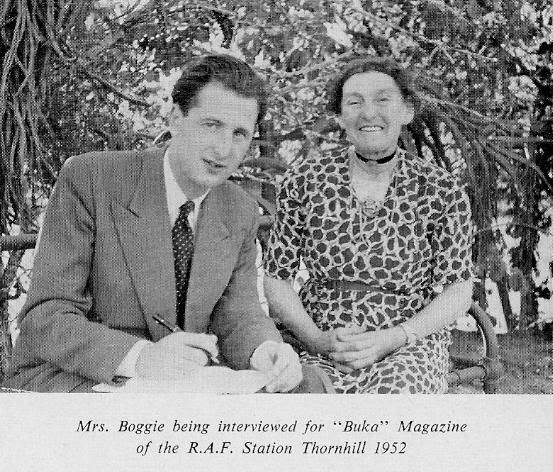
In September 1945, Thornhill fell into disuse until it re-opened as a RAF navigational school, and remained so for 7 years. Sometime in the 1950’s Thornhill was re opened as a flying base for the Royal Rhodesian Air Force. In 1956, a detachment arrived to train pilots on the newly acquired Provost piston engine aircraft and shortly after that training was started on the Vampire Jets.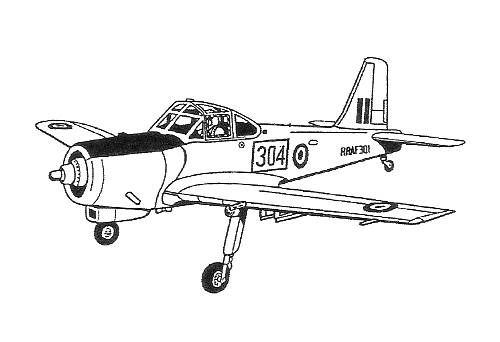
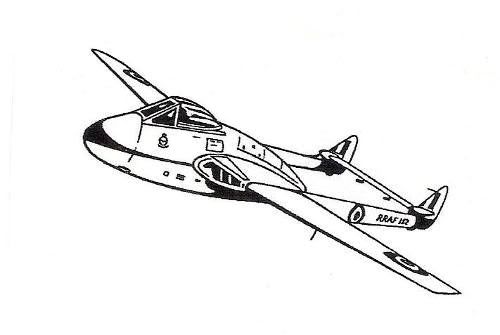
In the above text it refers to Jeannie being deeply affected by the crash and death of a young pilot on her farm. Not many realize that she had further grief to bare regarding a particular aircraft accident.
Jimmy Manson, the son of her brother Alexander was also killed in a flying incident in 1942 whilst flying Mustangs.
I quote from an e mail received from Akki Manson, Jeannie’s nephew and Jimmy Mansons brother ( Akki is still going strong at 80 in Scotland when I received this mail in 2011)
Jimmy was my only brother and joined the Gordon Highlanders on the outbreak of the war.. Lack of action made him transfer to the RAF (Army co-operation) where he gained his wings in early 1942. During training he flew a variety of single engine aircraft. All are recorded in his log book. His first squadron was No. 26 based at Gatwick which was equipped with the new American P51. It was called the Mustang by the British. He was recorded as being on patrol over France during the raid on Dieppe on 19th August.
He was killed on 26th August in a collision with another aircraft on landing at Gatwick after a sweep over France. He is buried at Brookwood cemetery.
Until and’ IF’ they gained their wings, Army Co-operation members had to wear regular army uniform and only gained RAF uniform after graduation. If you did not qualify you had to return to your original army unit.
Jimmy’s graduation photograph shows him getting his wings resplendent in Gordon Highlanders kilted uniform.
The other group picture is of No.26 fighter reconnaissance A.C. Course . Old Sarum (UK), June 1942.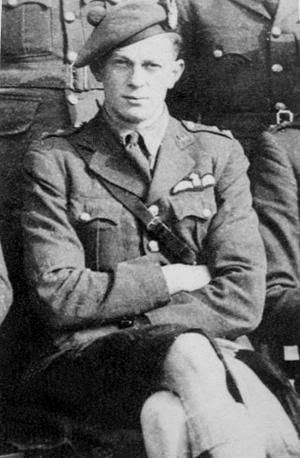
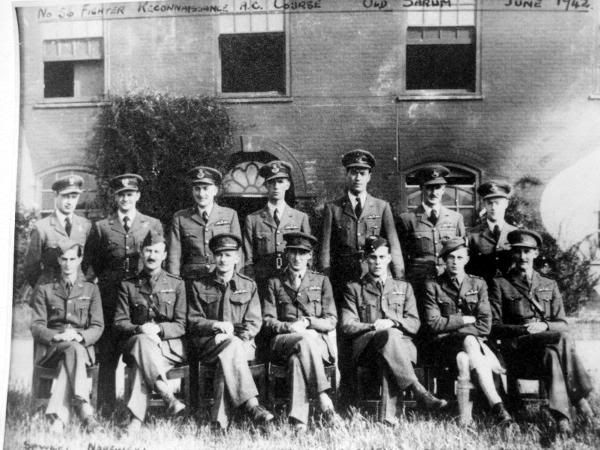
Jeannies Views on the Air Force
After all the above comments about Jeannie and her feud with the Air Force , it is pertinent that I mention some of her own views on the issue. These are a few anecdotes taken from her book “A Farm and Husband in Rhodesia”
One time a Harvard knocked the top branches off a 60’ gum tree 20 yards from my house. The tree slowly died and I asked the lads why this was so. They said the tree had probably got an electric shock. After that I lived in terror that the Harvards would strike my house , and myself and that the house would get an electric shock, and slowly die.
One morning we were trying to put medicine into the eye of an unruly cow. Suddenly there came a tremendous zooming overhead, and a roaring and revving Harvard just missed of top of the tree we were working under. The terrified cow jumped out of our hands, knocked me over and trampled on my knees.
When I complained to the camp CO, he said “why didn’t you take the number of the plane?"
I replied, how could I when I was crawling on all fours as fast as my injured knee would allow me, to get away from that jumping cow. My eyes were towards the rocky stone cattle kraal, not towards the roaring Harvard.
The pilots were full of youthful high spirits, sometimes dangerous. Once a plane began a loop the loop. It failed to right itself and came down and crashed. I visited the wreck. Never again! Heads in one place, feet in another, a scalp with brown wavy hair, no face, a boot with a foot still inside. A ghastly horrible haunting sight.
THE DANCE OF THE HARVARDS
My memory has catalogued as the most terrifying, yet fascinating bit of fooling around by the Harvards. A happening which I named “The Dance of the Harvards”
A number of pupil pilots had just passed out and at 3 a.m. in the morning, apparently a few of the lads full of mischief suggested they should have a daredevil stunt in the bright moonlight. As a playground they had nearly a 5 mile stretch of open country, beneath them my little house.
From sheer exhaustion I had been almost asleep, right underneath the zooming which had gone on at 5 minute intervals over my house for some time. Then I started up in terror, what pandemonium, I ran outside and fled into the bush 200 yds away, but the fascination of the dancing Harvards , turning and twisting, crossing, interlacing, drew me awestruck to my own kopje, which afforded a splendid view.
Never had I seen so many Harvards in the sky at one time, a maze without a plan. The whole scene reminded me about Robbie Burns description of the witches dance in his poem “Tam o’ Shanter” ( which I parodied)
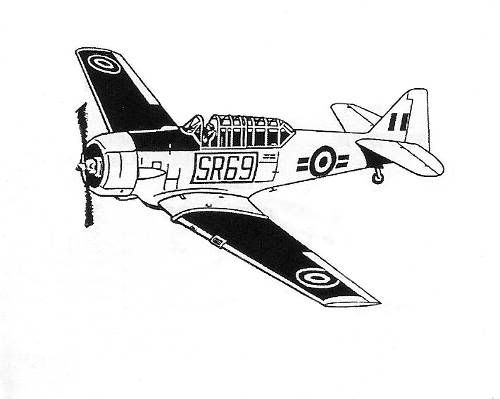
As Jeannie glowered, amazed and curious,
The mirth and fun grew fast and furious,
The Harvards loud and louder blew,
The pilots quick and quicker flew,
They danced, they set, they crossed, they cleekit,
Till ilka Harvard sweat and reekit.
-------------------------------------------------------------------------------------------------
A little bit more history about the Thornhill area may be of interest to Gwelo and ex Air Force folk.
Colin Lyle who lived on the farm next door to Thornhill describes some of the history of the farm and the early owners.
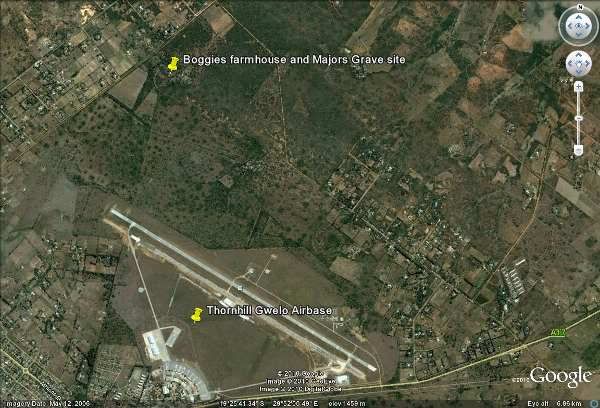
We lived on Thornhill Farm, next door to Jeannie’s and shared our southern boundary with the northern boundary of the airfield. Our house was almost due north of the control tower and we endured for many years , like Jeannie, returning aircraft screaming overhead in beat ups before breaking off to land.
The title deeds of our property “Thornhill Farm” was named after an area in UK where the original owner came from in the early twenties. Sammy Jewell, the later owner was paid very little for the part of the land that was appropriated by the Southern Rhodesian Government, if my memory serves me correctly it was 5 shillings an acre and because he lost the main borehole which was down near the control tower, the government drilled two boreholes higher up near the homestead. This land grab made his farm unviable and he made most of his income thereafter from a few cattle and sheep, and the infamous blue gum trees down close to the airfield boundary.
All the arable land became the airfield which stretched nearly to the Umvuma Road where it adjoined the McDonalds Farm( EI EI O!) Jock McDonald the lawyer was the son and the daughter was married to the late Basil Myles , who over the years I came to know well and respect. He told me most of these stories and had wonderful memories about days gone by , playing croquet on the lawns at the farm with the Jewells and Jeannie Boggie. Pity he never wrote a book!
The Boggie farm was unoccupied for many years, but the late Roy Fromberg rented it for grazing. It was sold by the Boggie Trust eventually in the 1980’s for the princely sum of $20,000.
Jeannies latter years
Jeannie battled on with her farming until virtually her dying day. She was certainly a courageous lady even in old age as this report proves regarding an attack on her when she was 85.
With Acknowledgements to The Gwelo Times 1962. ( abridged)
Gwelo was shocked by the news that the 85 year old Mrs Jeannie Boggie had been attacked and robbed at her home on Craigievar Farm at midday last Friday. Three assailants entered her house and knocked her to the ground with a blow under her chin. They threatened to kill her whilst pointing a revolver at her.
To get rid of them without more harm to herself she gave them all the money she had in the house and eventually after ransacking the place, they fled.
Jeannie then hurried to her nearest neighbours , The Foxes, who telephoned the police.
Jeannie was taken to hospital and treated for deep cuts bruising and scratches but refused to stay overnight , and returned to her own home.
Mrs Boggie declared the next day that she felt perfectly well and quite unshaken and was preparing to record the incident in another book of her memoirs.
An amazing woman who lived on Craigievar Farm for just over 50 years before her death on 23rd April 1967 from thrombosis and enteritis.
Most of us who were involved in the Air Force or lived in the Gwelo area during her lifetime will certainly remember her as a THE LEGENDARY JEANNIE.
However her” ain folk” back in Scotland did also not forget her and I quote from an article by Evelyn Munroe who wrote a short biography on Jeannie in Old Meldrum, Aberdeenshire as recently as 2006.
Evelyn even tried to get a road or street named after Jeannie in her home town but without any luck
Jeannie Boggie MBE (1876-1967) Famous daughter of Old Meldrum
Jeannie Boggie was born Jane Marr Manson at Kilblean , Old Meldrum in 1876, a sister of Captain Alexander Manson and a cousin to Sir Patrick Manson. She was also aunt of MBHS chairperson, Akki Manson.
As a young woman Jeannie became a suffragette and was recognized as a champion of women’s rights in Scotland.
In 1917, at the age of 41, she totally surprised her family by eloping to Rhodesia with pioneer, Major William Boggie, whose mother’s home was Willowbank, South Rd, Oldmeldrum. Jeannie, with her keen sense of adventure and fearless was well suited to life on the ranch called Craigievar, near Gwelo.
Sadly, in 1928 her husband died suddenly. She must have been heartbroken because she loved her Major dearly. However she continued to run the farm, living alone, despite being nearly murdered on one occasion and stoned on another, until her death in 1967 at the age of 91.
She became a devoted and meticulous chronicler of the achievements of the pioneering men and women of Rhodesia, writing and publishing three highly acclaimed books. Much of the history of Rhodesia , would have been lost without her determined efforts to preserve it.
Until well into her eighties she did her rounds and rode into Gwelo on horseback. She embraced charitable works and worthy causes , often clashing with
authorities in the process. She loved animals and would not tolerate cruelty to them. An opponent to be reckoned with, her one woman campaigns were legendry. She cared deeply about the elderly and gave property and generous financial support to create homes for old folk in Gwelo.
For her work in Rhodesia she was awarded the MBE.
Evelyn Munroe September 2006 Old Meldrum, Scotland.
What a superb and accurate tribute to Jeannie by Evelyn Munroe of Old Meldrum , Scotland. A fitting end to this story of such a wonderful lady. Finally from the words of Eddy Norris, my co writer “Mrs. Boggie was different! But even now, the members of the Air Force, that spent time in Thornhill, their eyes light up when the name “Jeanni Boggie” is mentioned.
PERSONAL ANECDOTES
I have added here some anecdotes from people who had actual contact with Jeannie and I feel these give a more personal insight to her real character.
From John and Marlene Fox.
Our’ Foxes’ Burnside brickfields was adjacent to her farm in Ridgemont and Jeannie used to visit our store for odds and ends. I can recall her buying a coke or for 3 cents, sticky buns, a favourite of hers, as big as a hand and covered with sweet pink sugar topping. As kids we often visited her homestead so see all her Matabele memorabilia, spears and shields etc . We shouted loud and long before approaching the house to make sure she had seen us, failure to do this could lead to the shotgun being poked out of the window.
Her burglar alarm comprised a big heavy chain that she passed through the door handle and sash window handle and around various bits of furniture. Anyone opening the door would have caused an enormous crashing and banging , followed no doubt by the unleashing of the dreaded shotgun.
The skull on the sideboard was of Rueben, her favourite horse. She rode sisde saddle till 81 when she fell off and broke her hip. Her boss boy was called William , almost as old as she, and a faithful servant till the end. She and he looked after a few scrawny cattle and some chickens. She de ticked the cattle by hand with William, an exercise I witnessed on many occasions.
My dad once asked her about the rumour that she kept her husbands remains under her bed and polished them occasionally- nonsense she said, he was buried in a cheap wooden coffin that the white ants got at, so I had to dig him up and have him buried in a lead lined one. Admittedly I had to clean him up a bit before putting him in the new coffin.
From Brian Pym
I was a member of the BSAP , stationed in Gwelo from mid 1960 to mid 1970, and have very fond memories of our association with the Rhodesian Air Force. Quite co-incidently I can comment on Mrs Boggie’s alleged taking pot-shots at the Thornhill aircraft. Whilst I personally never witnessed such incidents, there were over the years numerous complaints to the Charge Office , not only from Mrs. Boggie herself about the noise from the aircraft and threatening to shoot them down , but also from neighbouring properties advising that gun shots had been heard from the vicinity of her property. It became common knowledge after a while that she was in fact “having a go” where she could. The chance of her ever hitting the aircraft was very remote because of the speed at which they travelled, the dense tree foliage , and that she was armed with an ordinary shotgun of the day.
In this context I have recently recalled the following incident from our squad memories.
Gwelo Urban Charge Office, my first posting and shift work. The work was varied and interesting- dealing with the public, taking reports, filling out forms, initial report enquiries on site, beat patrols etc etc.
Of course in this regard we were under the direct control of the Member in Charge shift and the most awkward of situations was always as per normal, directed at the most junior. Shortly after my arrival I was instructed to attend a complaint by Jeannie Boggie , widow of the late Major Boggie, pioneer and remembered by Boggie’s clock in the middle of Gwelo, around which the whole town gathered to celebrate each New Year. I proceeded to Mrs. Boggie’s small holding which was situated at the one end of the Thornhill air force base. As I was about to get out of the truck there was a loud bang- Dear old Jeannie had just shot a large snake on the rockery next to the pathway leading from the driveway to the house. Mrs Boggie was a charming old dear, although somewhat eccentric and her complaint was that the newly arrived Canberra’s and Hawker Hunters were making too much noise. I had to sympathise with her as they were very noisy on take off and landing on the newly extended runway which bordered onto her property.
I entered the house where I was given a guided tour of the achievements of her late husband including viewing the mounted skeleton of her husbands horse in her bedroom and sight of her husbands bones in a box under her bed.
Needless to say there was a roar of laughter from the Member in Charge and others when I returned to make my report as Mrs. B was considered a regular nuisance.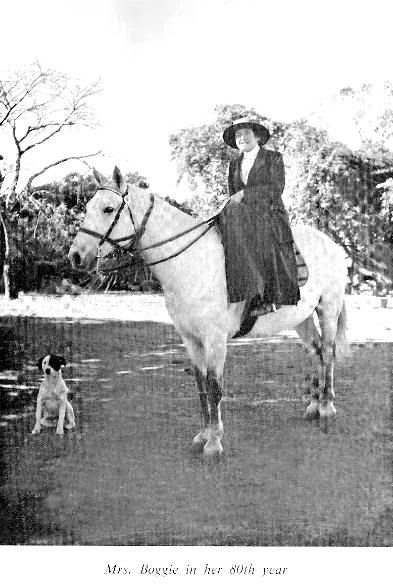
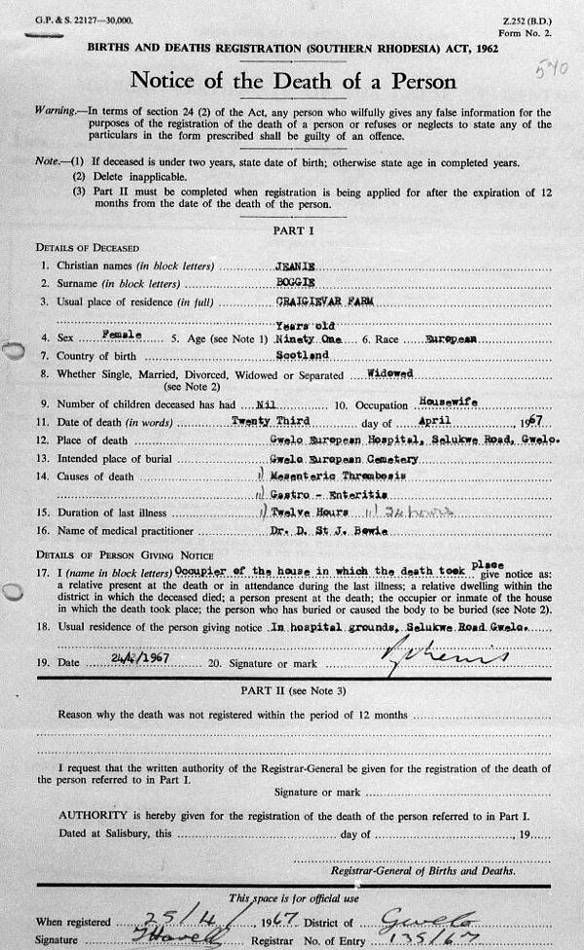
--------------------------------------------------------------------------------------------------
Major William James Boggie ( 1862-1928)
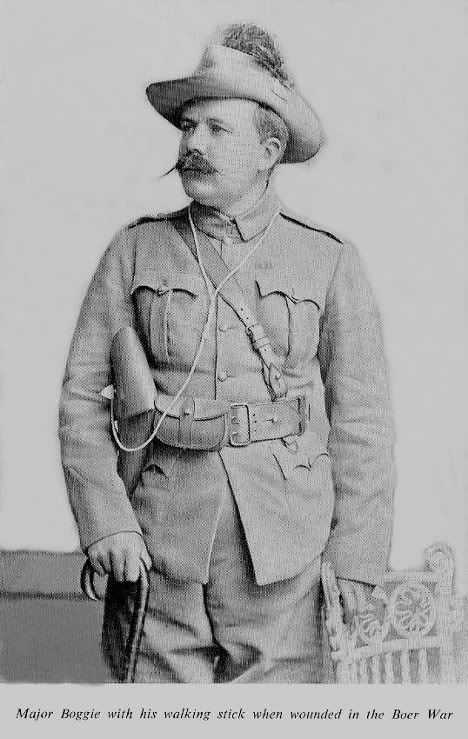
William James Boggie was born in Edinburgh on August 20th, 1862 at 8 St James Street, Portobello. He had an elder brother Alexander who was about 15 months his senior, and who will be mentioned later as he also became a Rhodesian Pioneer before William.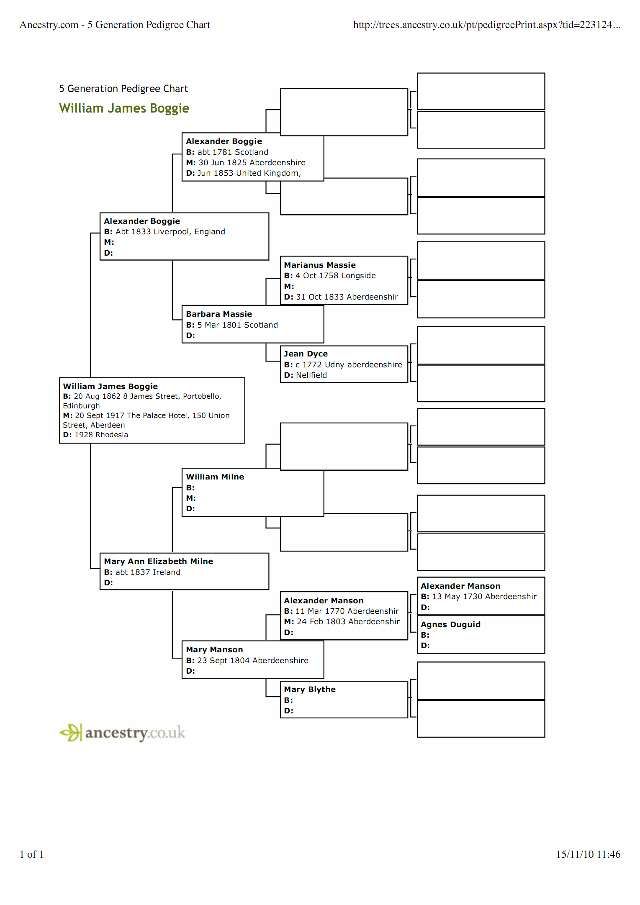
There was also a younger brother John, but he appears to have had no desire for travel and remained in Scotland and I can find no information on him.
William’s father (Alexander) is listed in records as both a bank clerk and land proprietor.
They were presumably fairly wealthy as the 1861 Scottish census shows that there were two servants living in the house.
The Boggie brothers were third cousins to Jeannie Boggie nee Manson as they had the same great great grandparents.
I have no information on his education but I should imagine that it was been similar to his elder brother who was educated both privately and at various public schools in Aberdeen.
The family must have moved from Edinburgh to Aberdeen at some stage as in 1881 records show both brothers lodging at Old Machar, Aberdeenshire. It also states that William was working for some time as a banking clerk.
He must have got bored with this as it is mentioned that after some ‘SLIGHT’ banking experience, he moved to Australia and served for ten years with the Australian Commonwealth Forces in Queensland with the rank of Lieutenant.
His brother Alexander had already moved across South Africa and possibly lured William across to Africa as Alexander was doing quite well after the Kimberly diamond rush days, and was also busy seeking mining concessions in Bechuanaland and Matabeleland.
Sometime in 1894 William Boggie left Australia and arrived in Rhodesia.
With the commencement of 1896 Mashona and Matabele rebellion and with his previous ten years of military background he soon became heavily involved in this military saga.
He commanded C Troop of Bulawayo Field Force and led the storming party in the attack against the Matabele who were in the heights of the infamous Kopje, Thabas-Induna on the outskirts of Bulawayo. (There is a full chapter in Sykes Book, With Lt. Colonel Plumer in Matabeleland describing the raid) He was also at some stage involved with the Mashonaland Mounted Police.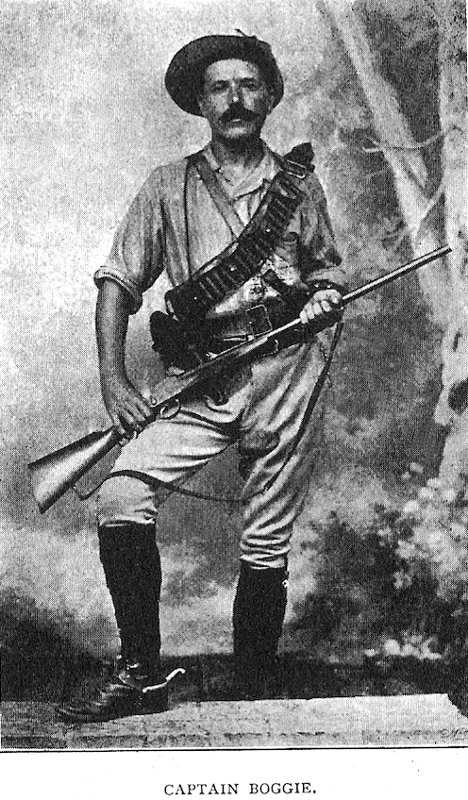
At the cessation of hostilities in 1896, I presume this was when he wandered around Rhodesia and decide to purchase his piece of land on the outskirts of Gwelo which he named Craigievar Farm.
Peace did not last long and during the second Boer War 1899-1902 he was recruiting officer for the Scottish Horse Imperial Yeomanry from January 1901 to April 1901.
He was then injured by being thrown from his horse and was invalided back to England in June 1901. He must have recovered quickly as he joined the 5th Militia Battalion of the Manchester Regiment in October 1901
He also served in various operations in the Transvaal, Orange Free State and Cape Colony, served subsequently with the 5th Manchester Regiment. He was Commander at Karreefontein and Riet Spruit at close of hostilities in 1902.
He received Queens Medal four clasps and Kings medals and two clasps.
He is then listed as returning to England on the ship Briton in July 1902.
It was presumably sometime between these two trips in 1901 and 1902 that he first proposed to Jeannie Manson.
After the Boer War and his brief trips to England, he returned to Rhodesia and commanded the Southern Rhodesian Volunteers at Gwelo.
From 1902 onwards it appears he concentrated on his farming and business activities in Gwelo. Besides his farm Craigievar, he conducted auctioneering plus a market for the sale of farming produce etc.
It is not known why he did not return to Scotland and collect his fiancée, Jeannie during this period of relative peace after the turmoil of the Rebellion and the Second Boer War.
Peace was not to be for long, as in 1914, at the commencement of WW1, William Boggie was off again to fight for King and Country.
I can find no details of his WW1 regiments but it appears he was involved in the fighting in France. The War continued until 1918 but Boggie who had now reached the rank of Major was given early release in 1916/17. This is possibly due to his age (55) and problems with his old injury from the Boer War.
In September of 1917 he returned to Scotland where he eloped and married his fiancee of 17 years, Jeannie Manson. The couple immediately left by boat for South Africa and after arriving in Gwelo commenced life in this small African town as the Major and Mrs Boggie.
It is apparent he was a very enterprising man and he must have been highly regarded in the town of Gwelo.
Over the years he was editor of the Gwelo Times Newspaper, Chairman of the Gwelo Board of Executors, Hon Secretary of the Gwelo Sporting Club, secretary of the Gwelo Chamber of Commerce.
He was an enthusiastic Mason and held Grand Lodge rank in the Scottish constitution and was founder of Alan Wilson Lodge , Bulawayo and the Gwelo Lodge .
Being involved in all of the above it was a natural progression to get involved in politics and he was a member of the Midlands Legislative Assembly from 1920 until 1928.
The Major’s Dream – Wankie Game Reserve.
It is not a well known fact that if it were not for the endeavours of the Major, there would possibly never have been the Wankie Game Reserve as we know it today. Eventually his enthusiasm and tenacity paid off and the rest is history.
I quote from an abridged article by W.D. Gale which he produced for the 50th anniversary of the Game Park.
“It may seem almost a contradiction in terms, but it is to a soldier that credit is due for the concept that areas of Rhodesia should be set aside for the creation of game reserves, in which wild animals could safely roam and live out their lives free from the threat of the Hunters gun.
Whilst he was a junior member for Midlands Legislative Assembly he introduced a motion that the Government take into consideration at the earliest possible date the advisability of proclaiming a game reserve. He was unable to suggest exactly where the game reserve should be situated but he favoured the Wankie area which was largely uninhabited and unsuitable for farming.
His fellow legislators were divided in their reactions, some supporting his proposal with enthusiasm , others raised objections.
The Major battled on and eventually the Government accepted in principle Major Boggie’s motion and Wankie was eventually and officially declared a game sanctuary on February 24th, 1928.”
(Out of interest, Ted Davison , the first warden of Wankie , took up his duties in October 1928.)
The Major was buried on his Gwelo farm, Craigievar on 10th February 1928.
Below is the tribute by Jeannie to her beloved Major on his death.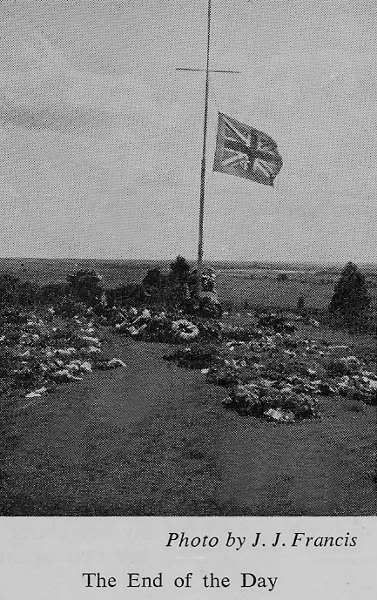
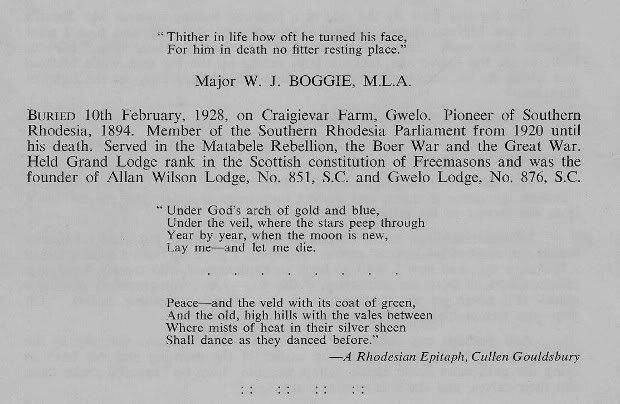
Text reads:-
"Thither in life how oft he turned his face, For him in death no fitter resting place." Major W. J. BOGGIE, M.L.A. Buried 10th February, 1928, on Craigievar Farm, Gwelo. Pioneer of Southern Rhodesia, 1894. Member of the Southern Rhodesia Parliament from 1920 until his death. Served in the Matabele Rebellion, the Boer War and the Great War. Held Grand Lodge rank in the Scottish constitution of Freemasons and was the founder of Allan Wilson Lodge, No. 851, S.C. and Gwelo Lodge, No. 876, S.C. "Under God's arch of gold and blue, Under the veil, where the stars peep through Year by year, when the moon is new, Lay me—and let me die. Peace—and the veld with its coat of green, And the old, high hills with the vales between Where mists of heat in their silver sheen Shall dance as they danced before."
A Rhodesian Epitaph, Cullen Gouldsbury."

--------------------------------------------------------------------------------------------------
Alexander Boggie (1861-1922)
Alexander Boggie was born on 8th May , 1861 at Liverpool, Lancashire, England
His father was also named Alexander and his younger brother was William (‘Major Boggie”). Alexander was approximately 15 months older than William.
It may seem odd that the elder brother was born in Liverpool and William, a short while later born in Edinburgh but the Boggie’s seemed to have had family ties in both Scotland and England (Liverpool) going back to their grandfathers days.
The Christian name Alexander can become quite confusing in the Boggie family tree as this name crops up for fathers, grandfathers and in some cases great grandfathers on both the paternal and maternal sides of the family.
Records show that he was educated privately, and at various public schools in Edinburgh, Aberdeen and London.
His education however must have been rather disjointed and complex as it states the family went to South Africa in 1869 when he was about 8 years old. It is mentioned that he was at the diamond fields of Kimberly in 1871 when the great mine was discovered. I cannot find any reason for his parents to have gone to South Africa, possibly his father was transferred there by some banking company whom he worked for, or like many other to seek a new life, excited by both the diamond and gold fever which was quite acute at that time.
He returned to Scotland with his mother in 1875 on the death of his father, this must have made him about 14 years old so one wonders how he managed all his schooling in both England and Scotland.
He returned to South Africa in 1883, then a young man of 21, and presumably tried his luck with various business enterprises in the boom town of Kimberly. He also joined the rush to the De Kaap and Barberton gold fields so he certainly had the mining bug well in his system.
He visited Swaziland in 1886 and opened negotiations with Umbandine, the Swazi King , with a view to getting a gold concession in this country. This he succeeded in doing so and as soon as this became publicly known a rush for concessions to Swaziland took place.
In 1888 he visited Matabeleland on a similar mission to try and gain concessions from Lobengula as it was thought that there were similar great gold deposits to be found there, equal those in the Rand .
In this particular venture to Lobengula he joined forces with J. Cooper- Chadwick and a fellow named Wilson. Sometime during these prolonged concession seeking efforts he split from this partnership as he appreciated the strength of the other parties also pressing the Matabele King. The main contenders, namely Rudd and Maguire, whom he knew were backed by the then powerful Cecil Rhodes so he did not press for his own claims. History shows that the Rudd Concession was eventually achieved for Rhodes’s syndicate although the actual legality of this concession was always regarded as doubtful.
It is interesting to note here that Alexander’s companion, Coooper-Chadwick spent nearly three years on the outskirts of Lobengula’s kraal , some of this was owing to his tenacity and some of it he states was involuntary as at times he was a semi prisoner and not allowed to leave.
Cooper-Chadwick wrote a book about his adventures called “Three years with Lobengula” ( re printed in the Books of Rhodesia series by the late Lois Bolze)
Alexander remained in the new Rhodesian town of Bulawayo in the early 1890’s after the Pioneer Column entered and occupied the country on behalf of the British South Africa Company. By that time Lobengula had fled northwards , chased by the BSA Co’s troops and died somewhere in the Gwaai River area.
Alexander was soon to be involved in both the Matabele rebellions of 1893 and 1896 and at one stage was specially commissioned by the authorities to procure from the Bechuanaland Protectorate( Botswana) and expedite the forwarding of provisions to the beleaguered town of Bulawayo.
During the second Boer War of 1899-1902 he acted as a special correspondent for the Rhodesian press in this campaign.
When peace eventually came to Rhodesia at the end of 1896 he appeared to have been well settled in Bulawayo and took a great interest in it’s affairs both commercial and otherwise.
He was on the board of various gold mining, land and other companies in Bulawayo and on most public bodies of the town, plus being Hon. Chief of the Bulawayo Caledonian Society.
He certainly had no apparent interest in military matters , unlike his younger brother ,”The Major”, and he never married, and as I previously mentioned, there appeared little social contact with ‘The Major’ or Jeannie Boggie.
Alexander also wrote a book on his experiences in Rhodesia and is titled “ From Ox Wagon to Railway”
The interesting thing about this book was that is was the FIRST book to be printed in Rhodesia by the Times Printing Works Bulawayo in 1897.
As he had entered the country as early as 1888 and had been involved in the Rebellions of 93 and 96 he was naturally entitled to membership of the Rhodesia Pioneers’ And Early Settlers’ Society.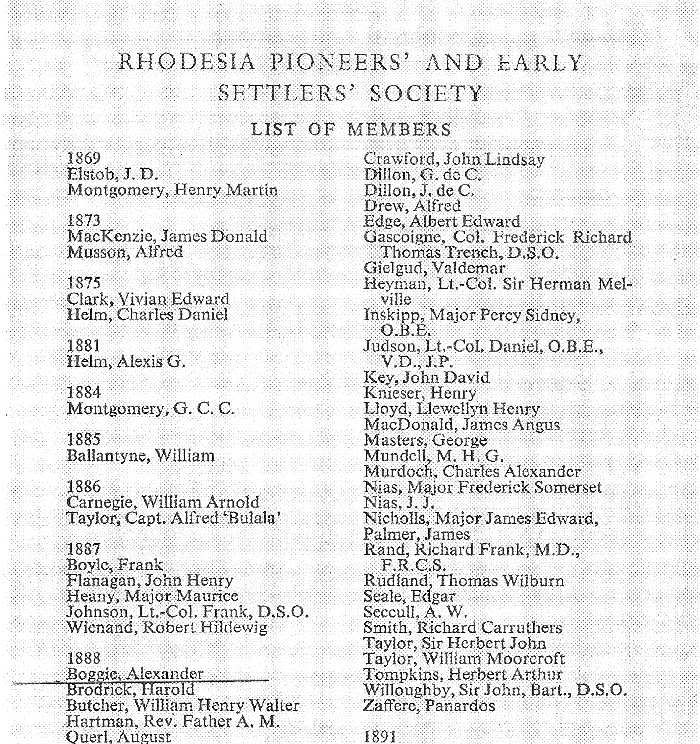
At some stage he left Bulawayo, possibly deciding to retire, and returned to his beloved Old Meldrum in Scotland. There he died on the 5th of October 1922 aged only 61. His death certificate describing the cause of death as acute bronchitis and oedema of the lungs.
He is buried in the Old Meldrum cemetery and Evelyn Munroe kindly sent this recent photograph of his headstone which reads as follows:
Here lie the remains of Alexander Boggie, a pioneer of Kimberly, Barberton Rand and Rhodesia. D . 5th Oct. 1922, son of Alexander Boggie of Aberdeen, Natal and Liverpool: also his mother M.A.E. Milne d. 4th Mar.1928, wife of the last named Alexander Boggie.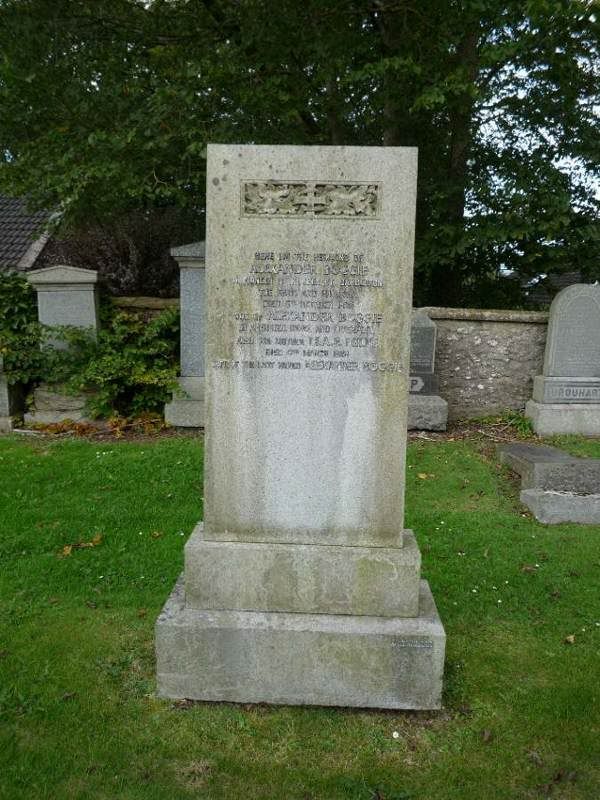
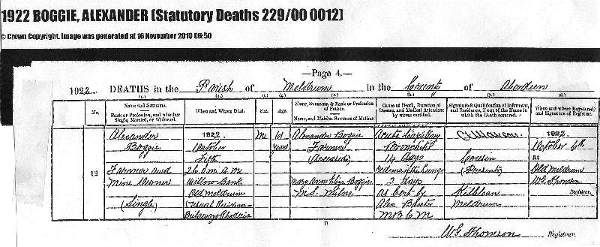
End of Article
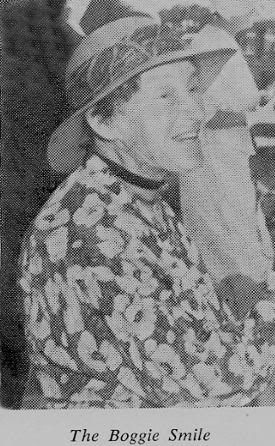


5 Comments:
Nick Baalbergen (Intaf) Writes:-
Valuable piece of Rhodesian history now recorded and available on the web, thanks to the two of you.
I was very excited to find your fascinating blog - the intrepid
Jeannie Boggie's mother, Jane Allison Marr, was the sister of my
husband's great grandfather, John Marr (1849-1914).
I was particularly interested to read that you have contact with
Jeannie's nephew, and wondered if you would ask him whether I might
get in touch with him? I would be very interested to find out if there
are any photographs or James Bruce Manson diary extracts relevant to
our research - all the Marr family photos were lost in the 1970s after
the death of my husband's grandmother, so we are always hopeful of
finding relatives who might be able to help us replace them.
Would we be able to use a copy of the photo that shows Jane Allison
Marr with her husband and daughter, and a photo of Jeannie at Kilblean?
Sorry this is so longwinded!
Fascinating story which I can't wait to pass on to my husband!
Kind regards,
Elizabeth Donnelly
Sandra Worth Writes:-
I have just read your article on the Boggies of Rhodesia and found it fascinating. In it you mention John Boggie the younger brother. I think that he was my great grandfather and left Scotland and went to live in India. My grandfather Kenneth Boggie was born in India and spoke of his father's brother who had lived in Gwelo. After Indian independence my grandfather went to live in South Africa and died there in 1963 at the age of 70
In the mid fifties my father Rob Pfaff lived on Christmas Avenue, Plot No 3, Ridgemont about two kms from Mrs Boggie's farm. Mrs Boggie would from time to time write to his father (my grandfather) asking him to shoot the pheasant as they were digging up her newly planted maize. He spent alot of his teen years on this farm and remembers the boss boy William very well. He also remembers the huge gun collection which Mr Boggie must have collected over the years. One day when getting the old twelve bore hammer shotgun from her, he enquired as to the whereabouts of William. "Oh" she said "I have fired him as he became slow and lazy". Bear in mind the old fellow was also fairly old himself. My dad also remembers the white horse as it chased him and his friend Stanley Want around the orange orchard. He thought the horses name was Jack.
Apparently all the rifles were left to the convent school in Gweru (Gwelo) with all her other belongings. It has been wonderful reading about the Boggies.
Many Thanks.
Eddie Pfaff.
who the hell is photo bucket to steal my photographs?? Bastards
Post a Comment
Subscribe to Post Comments [Atom]
<< Home